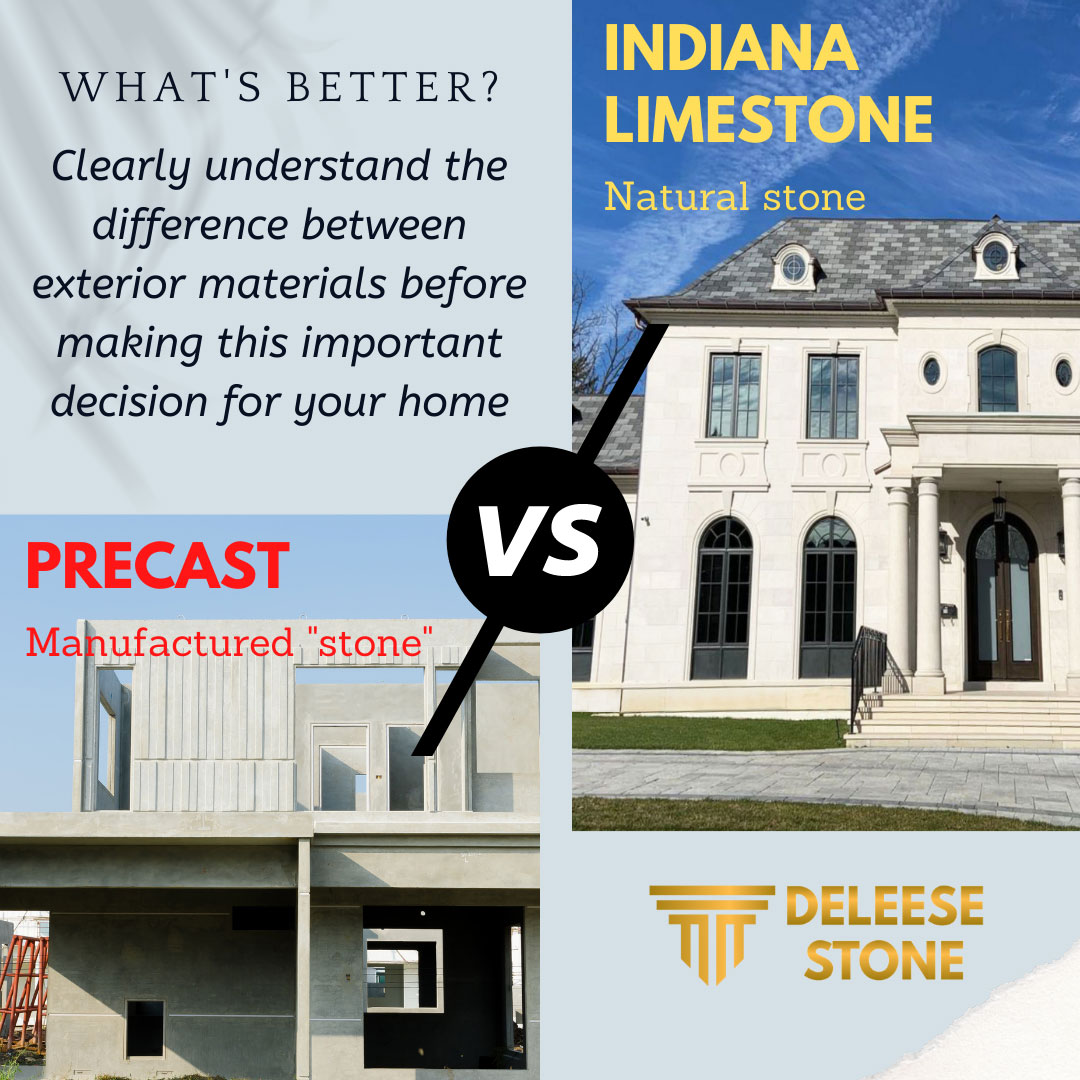
Often architects refer to “precast” when they mean limestone and clients come to us confused as to what they actually need for their project. Precast and limestone are two very different materials and comparing them is similar to the comparison of hardwood and laminate flooring. Precast (or cast stone) is an artificial material while limestone is a natural rock. While imitation stone (precast) is available at a lower initial cost, natural Limestone requires less cumulative investment due to it being maintenance free. The slight price increase for natural stone can be easily justified in the aesthetics and product life cycle. We have developed a detailed comparison fact sheet to help our clients better understand the difference between these materials and eliminate all confusion.
Key difference between limestone and precast:
Limestone is a natural stone and is a lasting choice, renowned for its durability, versatility, and exceptional natural beauty. It is an economical long-term option, rewarding initial investments with minimal expenses for maintenance over many years.
VS
Precast is a man made product with perceived cost advantages at purchase, and possible suitability for non-structural applications. Though it may initially resemble natural stone, this is actually a cementitious product, prone to cracking, crazing, chipping and staining.
What are limestone and precast made of:
Limestone is a natural stone that is chemically pure, averaging 97 percent plus calcium carbonate and 1.2 percent calcium-magnesium carbonate.
VS
Precast is 25% cement and 75% aggregates (sand, gravel), water and dyes.
Durability and longevity:
Limestone is incredibly durable and offers a consistency in colour and quality with a lifetime warranty.
VS
Precast’s main issues are durability and longevity. Inevitable water penetration in climates with freezing temperatures will cause:
- cracking due to expansion and contraction
- crazing: hairline cracks resembling a checkerboard as result of moisture absorption
- chipping, flaking, staining from debris causing stains that penetrate into porous surface. Cleaning is often ineffective and may result in pitting or further discoloration.
- unsightly repairs as dyes fade over time and obtaining a matching piece to make repairs is difficult. Blending the repair is highly improbable.
Attractiveness:
Limestone is a highly attractive, premium building material that has undeniable prestige and longevity. It is chic and luxurious with color and texture choices that will retain its beauty over time. Color variations: white, gray, silver buff, standard buff (cream/ivory)
VS
Precast from a distance can look much like real limestone. But even newer top-quality precast with more realistic surface mimicry is far from perfect and can be identified immediately at close inspection. Precast will also not retain its beauty overtime due to durability issues.
Limitations of use:
Limestone is ideal for any kind of structural and non-structural applications as it is incredibly durable yet flexible. It is also a freestone – it exhibits no preferential direction of splitting and thus can be cut and carved in an almost limitless variety of shapes and sizes
to match the requirements of the most demanding architectural designs.
VS
Precast should be avoided in:
- Applications requiring structural support
- Exterior uses subjected to extreme temperature fluctuations
- Areas where water absorption is likely
- Areas requiring minimal maintenance
- Applications where custom chiseling or cutting is necessary
Ease of installation:
All Indiana Limestone is made of one thing so installers don’t have to worry about hiding an ugly edge or matching stone colours. This guarantees beautiful results with minimal waste.
VS
As precast is a manmade product, there may be inconsistencies in colour and quality which require careful matching by the installers.
Environmental considerations:
Indiana Limestone is a natural product that is Green Building and Eco-friendly certified as it is:
- Inert – no VOC emissions or pollutants
- Easily extracted with low energy inputs
- Durable – lifespan greater than 100 years – and when decommissioned, can be reused or returned harmlessly to the earth·
- Eligible for Leadership in Energy and
- Environmental Design (LEED) Credits
- Virtually maintenance-free and will serve for many generations
VS
Precast stone manufacturing process requires intense energy and emits a lot of carbon dioxide into the atmosphere. The world’s greenhouse gas omission receives a contribution of 4.8% from concrete manufactured stone preparation.
We hope that this helps you understand the difference between these materials. We’re always happy to help answer questions so please don’t hesitate to reach out!
Deleese Stone Inc
